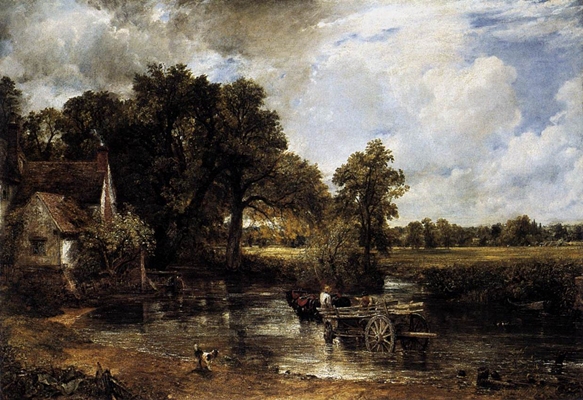The Hay-wain
John Constable
Click on the image above to see a larger version
Perhaps the most famous of Constable's images having been reproduced for the mass market not only as a print but on items for the home such as place mats etc. But the picture is so much more than a mass reproduction, it is perhaps the best of his work he has to offer, painted towards the end of his life he would have painted this scene in all kinds of variations many many times.
Indeed he felt that there was no better place to paint than the stour valley. He often choose to paint people in their work setting and this is no different, the carter has taken his horses and cart into the shallow waters, while the little dog looks on. Is the dog the carter's and the viewer can imagine him running up and down the bank yapping at his master to come out of the water to carry on with the journey.
The cottage in the background is Willy Lott's cottage which Constable also painted many times.
The painting although popular today was not well received when it was orginally exhibited in the Royal Acadamy, in fact it was not even sold. But when exhibited at the 1824 Paris salon it was received with enthusiasm. In 2005 it was voted the second best painting in any gallery in Britian.
Today the image is as popular as ever and there are many theories about what is happening in the painting including to do with why the carter drove the wain (cart) into the water. Why would he do this, was to to give the horses a drink or to allow them to cool off after all it looks like it is a hot summers day. Or could it be as some scholars say that the wain needed to go into the water to stop the wood drying out. The wheels would have to be kept from drying too much or they would splinter and break under the loads that they had to carry. Or was it simply that Constable liked the composition of the painting better that way so he painted the carter on his cart in the water. Whatever the reason the painting has been an enduring favourite since the Paris Salon in the middle of the 1820s.
The painting although popular today was not well received when it was orginally exhibited in the Royal Acadamy, in fact it was not even sold. But when exhibited at the 1824 Paris salon it was received with enthusiasm. In 2005 it was voted the second best painting in any gallery in Britian.
Today the image is as popular as ever and there are many theories about what is happening in the painting including to do with why the carter drove the wain (cart) into the water. Why would he do this, was to to give the horses a drink or to allow them to cool off after all it looks like it is a hot summers day. Or could it be as some scholars say that the wain needed to go into the water to stop the wood drying out. The wheels would have to be kept from drying too much or they would splinter and break under the loads that they had to carry. Or was it simply that Constable liked the composition of the painting better that way so he painted the carter on his cart in the water. Whatever the reason the painting has been an enduring favourite since the Paris Salon in the middle of the 1820s.
The Hay-wain
1821
oil on canvas
National Gallery, London
Related links
- Constable
- Romantics
- Paintings
- Oil on canvas
- 19th Century
- Titles
- England - John Constable
- Animals
- Buildings
- daily life
- Jobs and occupations
- Landscapes
- Men
- Rivers and Streams
- Transport
